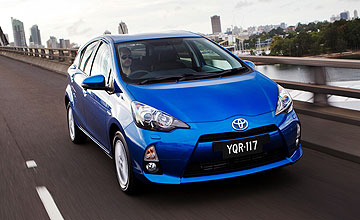BY MARTON PETTENDY | 13th Jun 2012

The second member of Toyota’s expanding Prius hybrid model family, which will be further extended by the seven-seat Prius V people-mover in May, undercuts Honda’s $29,990 Insight by $6000 to become Australia’s cheapest hybrid.
Now available for $10,000 less than Toyota’s larger Prius hatch – a facelifted version of which was also released this week, priced $1000 lower than before from $33,990 – the pint-size Yaris-based Prius C five-door is also available in flagship i-Tech guise from $26,990.
While sales of the regular Prius and Toyota’s Australian-made Camry Hybrid mid-sizer slumped to their lowest levels last year, the Prius C’s keener pricing and unique personality – “designed to attract an entirely new audience of singles, couples and young families” – is expected to make it the Japanese giant’s top-selling hybrid model.
While official sales targets remain sketchy and Toyota Australia says initial supplies its smallest hybrid are secure, local demand could exceed supply.
Sales have been strong in the US – where the Prius C attracted 1200 buyers in the first three days after it went on sale on March 12, eclipsing the February totals of Chevrolet’s Volt and Nissan’s Leaf – and Japan, where Toyota says it holds 120,000 Prius C orders following its launch last December.
“Prius C combines a compact exterior, spacious interior, desirable features, engaging driving dynamics, advanced technology and five-door hatchback utility with aggressive pricing,” said Toyota Australia executive director sales and marketing Matthew Callachor.
“Prius C adopts the name of the world’s best-known and best-selling hybrid vehicle, Prius, to communicate it has the advanced features and excellent fuel efficiency unique to Toyota’s hybrid vehicles.
“Prius C is further evidence of Toyota’s commitment to achieving greater market penetration for hybrids by making this core technology more attainable for a wider audience.”
Notwithstanding its new hybrid price benchmark, however, the Prius C still costs $9000 more than the cheapest Yaris, and up to $4500 more than equivalent-sized diesel hatchbacks, which emit more CO2 but offer similar fuel economy.
And, despite a pre-launch campaign that heralded the Prius C’s outstanding city fuel consumption of just 3.7 litres per 100km – bettering any petrol, diesel or hybrid car, including the regular Prius – official ADR 81/02 fuel consumption figures now show the Prius C consumes a combined average of 3.9L/100km.
That is as much as the larger Prius, which employs a bigger and more powerful 1.8-litre petrol engine, making the Prius C thirstier than the most frugal car currently available in Australia – Volkswagen’s Golf BlueMotion, which consumes 3.8L/100km and costs $28,990.
Furthermore, despite being powered by a 54kW/110Nm 1.5-litre Atkinson-cycle petrol engine – essentially a recalibrated and repackaged version of the MkII Prius engine, matched with a 45kW/169Nm AC synchronous electric motor and a 520-volt nickel-metal hydride battery to deliver a total output of 74kW – the Prius C emits more CO2 than the larger Prius hatch at 90 grams per kilometre (but less than the diesel Golf BlueMotion at 99g/km).
Like the established Prius, the C comes exclusively with a continuously variable automatic transmission (CVT) and rides on 15-inch wheels, but weighs a considerable 285kg less at 1120kg and is substantially smaller at 3995mm long, 1695mm wide and 1455mm high, with a wheelbase of just 2550mm.
Although the Prius is less aerodynamic than its larger five-door namesake with a drag coefficient of 0.30Cd, Toyota says the Prius C is better packaged than the Yaris on which it is based.
It is 110mm longer than the Yaris, liberating more legroom and hiproom front and rear, and providing “ample” space for five adults and 260 litres of luggage space, but the roof is 55mm lower.
In a Toyota first, the Prius C’s hybrid battery and fuel tank are positioned under the rear seat, which also features a 60/40 split-fold seatback, maximising cargo space and allowing for a full-size spare wheel.
As with the Yaris, suspension is by MacPherson struts up front and a torsion-beam at the rear, while the rake and reach-adjustable steering wheel is part of an electro-mechanical steering system. Turning circle is a tight 9.6 metres and there are 2.7 turns lock-to-lock.
The Prius C is expected to gain a maximum five-star safety rating and will come standard with seven airbags, electronic stability control, ABS brakes with electronic brake-force distribution, hill-start assist and a reversing camera.
Other standard features include keyless entry and starting, automatic air-conditioning, a 6.1-inch touchscreen display audio, CD player, Bluetooth audio streaming and phone connectivity, USB port with iPod connectivity, a 3.5-inch colour TFT multi-information display, cruise control, foglights and power windows/mirrors.
For an extra $3000, the Prius C i-Tech offers satellite-navigation with live traffic updates, alloy wheels, self-levelling LED headlights with washers, power retractable exterior mirrors, a larger rear spoiler, privacy glass, chromed side air vents, a premium steering wheel, and premium seat upholstery and interior trim.
Eight exterior paint colours include three bright new-to-Australia hues – Sunrise (orange), Aqua mica metallic and White Mist crystal pearl – while the interior is black with contrasting lighter colours for the door trims, seat surfaces and instrument panel.
Toyota claims that more than half of the Prius C bodyshell is made from high-tensile steel, cutting weight and fuel consumption, while its downsized hybrid-drive system is more than 40kg lighter than that of the regular Prius (201kg versus 243kg), with more than 8kg saved from both the transaxle and lower-output Ni-Mh battery.
The Prius C’s electric air-conditioning unit is thinner, lighter and 12 per cent more efficient, while an ‘Eco’ mode reduces fuel consumption by governing the air-conditioner and throttle control system of the beltless four-cylinder petrol engine.
Like the Prius, the C can be driven in electric-only mode for one or two kilometres, this time at speeds of up to 40km/h.
A fixed-price service package costs $130 for each of up to six scheduled services in the first three years or 60,000km.